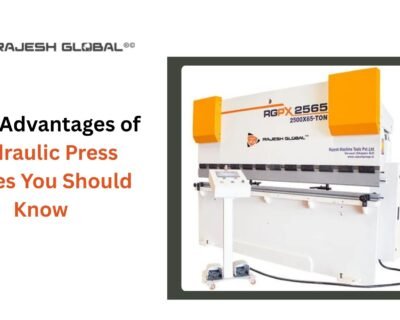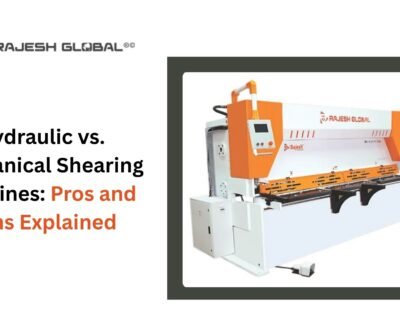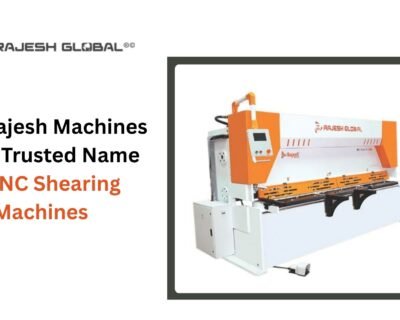Blog

Top Applications and Types of Sheet Metal Fabrication
The $188 Billion Industry That’s Redefining Manufacturing
Contents
- 1 The $188 Billion Industry That’s Redefining Manufacturing
- 2 The Five Fabrication Fundamentals That Define Everything
- 3 The Application Reality: Where Markets Meet Metal
- 4 The Market Acceleration Nobody Talks About
- 5 The Technology Convergence That Changes Everything
- 6 The Rajesh Machine Tools Integration Advantage
- 7 Three Critical Insights That Define Success
- 8 The Next Competitive Battleground
The global sheet metal market size was valued at USD 188.31 billion in 2023 and is projected to grow at a CAGR of 7.0% from 2024 to 2030. Yet here’s the paradox: while everyone talks about advanced manufacturing, 65% of fabricators still approach sheet metal work as if it’s 1995. They’re cutting, bending, and welding the same way their predecessors did—missing the revolution happening right under their noses.
The future belongs to fabricators who understand that sheet metal isn’t just material manipulation—it’s precision engineering at industrial scale.
The Five Fabrication Fundamentals That Define Everything
Sheet Metal Fabrication is the process of forming parts from a metal sheet by punching, cutting, stamping, and bending. 3D CAD files are converted into machine code, which controls a machine to precisely cut and form the sheets into the final part.
But this technical definition misses the strategic reality. Modern fabrication isn’t about individual processes—it’s about integrated workflows that compound precision at every stage.
- Cutting Revolution: Traditional plasma and oxy-fuel cutting are giving way to laser and waterjet systems that achieve tolerances under 0.1mm while reducing heat-affected zones to negligible levels.
- Bending Intelligence: CNC press brakes now calculate springback compensation, material variations, and tooling wear in real-time, eliminating the trial-and-error approach that has plagued fabrication for decades.
- Welding Precision: Different welding techniques, such as MIG, TIG, and spot welding, may be used depending on the material and application. Advanced systems now predict weld quality before striking the arc.
The Application Reality: Where Markets Meet Metal
Automotive Dominance In the automotive industry, roll forming creates door frames, window channels, bumper reinforcements, and body components that demand both strength and weight optimization. Electric vehicle production has intensified these requirements—battery enclosures, lightweight chassis components, and thermal management systems require fabrication tolerances that were unimaginable five years ago.
Aerospace Precision Aerospace applications push sheet metal fabrication to its absolute limits. Aluminum alloy components for aircraft structures require not just dimensional accuracy but metallurgical integrity. Every bend radius, every hole position, every weld penetration is critical to flight safety.
Construction Evolution Construction: Roll forming is used to produce roof and wall panels, structural framing members, gutters, and downspouts, offering durability and ease of installation. But modern construction fabrication goes beyond basic forming—architectural metal work now demands complex geometries and custom finishes that challenge traditional fabrication methods.
The Market Acceleration Nobody Talks About
The global sheet metal fabrication services market was valued at USD 10.3 billion in 2024, with expectations to reach USD 15.2 billion by 2034, growing at a CAGR of 4%. This growth isn’t driven by more of the same—it’s powered by applications that didn’t exist five years ago.
- Data Center Infrastructure:Hyperscale data centers require thousands of custom enclosures, cable management systems, and thermal solutions. Each component demands precision fabrication with rapid delivery schedules.
- Renewable Energy Systems: Solar mounting systems, wind turbine components, and energy storage enclosures represent fabrication challenges that combine structural engineering with environmental durability requirements.
- Medical Device Manufacturing:The medical device sector demands fabrication precision that approaches watchmaking—surgical instruments, diagnostic equipment housings, and implantable device components require tolerances measured in microns.
The Technology Convergence That Changes Everything
Companies increasingly adopt automation, robotics, and advanced software solutions to streamline fabrication processes. But technology adoption isn’t uniform—it’s creating a competitive divide between fabricators who integrate intelligent systems and those who simply buy better tools.
- Smart Material Handling: Automated material storage and retrieval systems eliminate handling errors while optimizing material utilization. Advanced nesting software reduces waste by up to 15% while maintaining production schedules.
- Predictive Quality Control: Vision systems and laser measurement tools now inspect parts during fabrication, not after completion. This real-time feedback prevents defects rather than catching them downstream.
- Digital Twin Integration:Leading fabricators create digital replicas of their processes, allowing optimization without production interruption. This capability is becoming essential for complex, high-value projects.
The Rajesh Machine Tools Integration Advantage
While the industry debates automation strategies, Rajesh Machine Tools focuses on the foundation that makes automation effective: precision equipment that delivers consistent results regardless of operator skill level.
Their CNC press brakes, shearing machines, and fabrication systems aren’t just tools—they’re platforms for process optimization. Whether you’re fabricating automotive components, architectural metalwork, or precision enclosures, Rajesh equipment provides the dimensional stability and repeatability that modern applications demand.
The strategic advantage isn’t in having the newest technology—it’s in having technology that integrates seamlessly with your existing workflows while providing the precision foundation for future growth.
Three Critical Insights That Define Success
Insight 1: Precision Compounds Every fabrication step either adds or subtracts from final part quality. The fabricators winning high-value contracts understand that precision isn’t achieved in finishing—it’s built into cutting, maintained through forming, and preserved through welding.
Insight 2: Speed Without Precision Is Waste Fast fabrication that requires secondary operations or produces rejected parts destroys profitability. The winning approach optimizes cycle time while maintaining first-pass quality across all processes.
Insight 3: Integration Beats Innovation Having the latest laser cutter doesn’t matter if your press brake can’t maintain the tolerances your cutter achieves. Successful fabricators think in terms of process chains, not individual machines.
The Next Competitive Battleground
The global sheet metal fabrication services market size is estimated to grow by USD 3.31 billion from 2024-2028, driven by applications that demand capabilities most fabricators don’t currently possess.
The question isn’t whether you can handle today’s fabrication requirements—it’s whether your processes can scale to meet tomorrow’s precision, speed, and complexity demands.
The fabricators who recognize this shift early will define the next decade of manufacturing excellence. The rest will compete on price in a shrinking market.
Choose your position carefully. The sheet metal fabrication revolution isn’t coming—it’s here.







